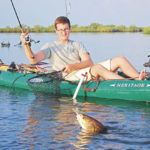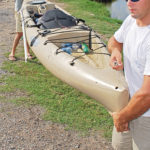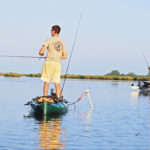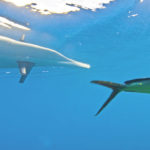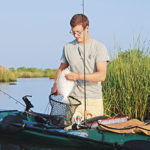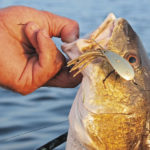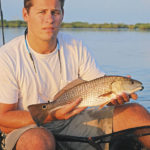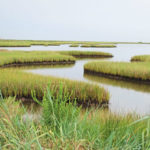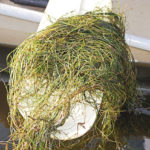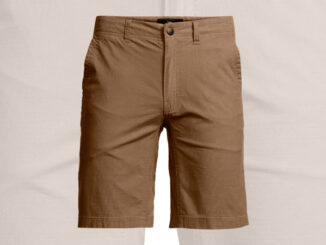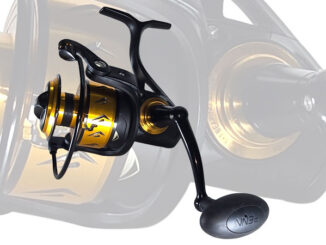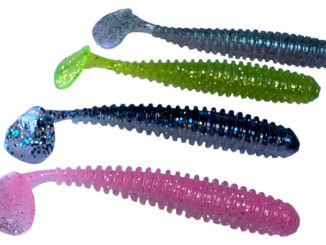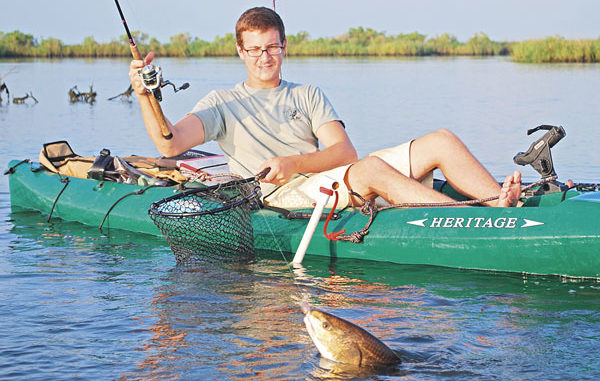
This sport is growing rapidly because it is so much fun and surprisingly productive.
I had been warned that kayak fishermen are passionate about their sport, and that they love to talk about it. Oh, how they love to talk about it!The two young men had plenty of time to talk. The trip from Mandeville to West Pointe a la Hache in the extended-cab pick-up began at 3:30 a.m. In the bed of the truck were three sliver-shaped kayaks that looked impossibly small for a 63-year old fat man like me.
By the dim street lights outside of Justin Miramon’s home, I saw that the 21-year old LSU student was slim and trim. More muscular but just as athletic-looking was his 23-year-old fishing partner Brad Jarvis. I immediately began to suspect that I had made a mistake in agreeing to try to jackknife my creaky knees into a kayak.
Trying to distract myself from thinking about the myriad ways that I might end up wet and embarrassed later in the morning, I began small talk as the truck jumped up on the 24-mile Causeway Bridge that spans Lake Pontchartrain.
“So just why do you guys like to fish out of kayaks?” I asked innocently enough.
The verbal gates opened.
“It’s effective; it’s not a second-rate way to fish,” replied Miramon, perhaps a little defensively. “But it’s inexpensive, certainly less expensive than fishing out of any powerboat.”
“Not only that,” chimed in Jarvis, “a kayak can take you into areas that powerboats can’t enter. You really get to be one with nature — that kind of thing. No motor, no noise.”
By the dash lights of the truck, I saw Miramon nodding his head in vigorous agreement.
“You can’t really experience the marsh going 50 miles an hour in a bay boat,” he said. “You never experience getting splashed in the face by a redfish. I have felt the vibration of a redfish drumming through the hull of a kayak. In a kayak, you see things in the marsh that would never see in a power boat.”
The two young men explained, almost in reverence, that by removing the noise and bulk of a motorboat from the sport, the angler becomes more of a stalker, more of a predator, more finely tuned to nature’s indicators of life.
“It makes you a better fisherman,” said Miramon. “It makes you focus more on a spot. In a bay boat, you make a few casts and go on. In a kayak, you are less mobile. It makes you figure out where the fish are.”
Fishing from a kayak is not a seasonal experience either, explained the pair. In the fall, winter and early spring, speckled trout are common in interior marshes. Redfish are plentiful in the shallow marshes year round, but summers are especially good for redfish.
Miramon added that fall and winter are his favorite time to kayak-fish the marsh, but that each fisherman will have different preferences.
Both men have fished enough from kayaks to be good at the sport. When Miramon turned 16 and was able to drive, he purchased a kayak and went out on his own. Not that he didn’t have fishing opportunities — his father Chuck loves to chase big speckled trout, and won a fully rigged boat in the 2008 Coastal Conservation Association STAR Tournament.
Jarvis met Miramon through the latter’s sister in 2006. He got his first kayak at Christmas of the same year, and the two made their first trip together in the marshes of Hopedale. They have been fishing together ever since.
Miramon gives a lot of credit to the Bayou Coast Kayak Fishing Club for getting him started. The group has almost legendary status amongst kayak fishing enthusiasts.
“At their website, you can get questions answered and post and view reports,” said Miramon.
Much of the website is open, although there is a members-only section as well.
The truck pulled over the levee at West Pointe a la Hache to a primitive launch site at which the kayakers have permission to launch their watercraft. They explained that the area, known variously as the Diamond Area or Magnolia, is used by dozens of kayakers all summer. Supposedly, it offers the best redfish fishing close to New Orleans.
The muggy night air assaulted our senses as we stepped out of the air-conditioned truck into the pre-dawn darkness. The sulfurous smell of the brackish marsh beckoned us, as did the hacking calls of several marsh hens. A bright full moon hung over the scene like a big silver moon pie, making the work of offloading the kayaks simple.
The moment of truth had arrived. I looked down at the kayak that Jarvis and Miramon steadied for me in the shallow water, sighed and slid my big self into the cockpit, expecting the worst.
It fit like a glove.
I grabbed my double-ended paddle, and soon had the kayak cutting donuts on the water like a pro.
With the faintest hint of dawn breaking over the watery landscape, the two men in their kayaks headed away from the levee and into the watery landscape, effortlessly skimming the surface like water bugs. Their destination was almost a mile away.
It was what is called in local parlance, “broken marsh.” The stands of marsh grasses were heavily pocked with ponds, large and small, and reticulated with bayous and sloughs. I tasted the water. It was almost fresh, just providing the barest of saline tingle to the tongue. Everywhere there were dense beds of bright-green submerged water plants. Nowhere was the water more than 2 feet deep.
They started with topwaters. Jarvis rigged a blue/silver Top Dog Jr., but noted that color isn’t important. The wounded surface action of the lure is what the redfish are looking for.
“We could catch fish by blind casting, just combing the area with casts,” he added, “but both of us prefer to sight them first, either tailing or crashing mullet.”
Miramon started with his favorite topwater lure, a blue/silver She Dog. The two anglers fished independently, but remained in sight of each other for the morning.
Everything was quiet for 15 minutes. By 5:50 a.m. the sun rising in the east had suffused the sky with a gorgeous pinkish-blue hue. Still nothing. Jarvis, to whom I was nearest, worked his lure all the way back to the boat on each cast, explaining that kayaks are so quiet that the fish don’t know you are present.
Then almost simultaneously, first Miramon then Jarvis got smashing blow-ups on their lures. Neither hit resulted in a hook-up. Jarvis grinned and explained the misses quietly.
“The thing about redfish and topwaters is that redfish are not genetically manufactured to feed on top,” he said. “They have subterminal mouths.”
Then Jarvis cast to a fin breaking the water’s surface, and was rewarded with a devastating blow-up. The treble hooks bit into this one’s mouth, but the 9-pound redfish was difficult to subdue.
Because of the lengthy tussle, Jarvis decided to keep the fish.
“I like to release fish that are fought under two minutes,” he commented, “but with hot water temperatures with its low dissolved oxygen, exhausted fish will often just run into a grass mat and die. I’ve seen it too often.”
He turned in his kayak, and carefully slid the fish head-first into a bag-like soft ice chest situated in the well behind the kayak’s cockpit. “About the hardest thing you do in a kayak is put fish in the ice chest behind you,” Miramon said.
Jarvis corrected him.
“It is the hardest thing to do,” he said.
Miramon and Jarvis stalked fish with the same style. They would paddle, pause and scan the water’s surface, then repeat the procedure. When one of them spotted a fish, he sprinted the kayak into casting distance, quickly drove his “Cajun anchor,” a pvc pipe with a T-handle, into the mud to steady the boat, then made his cast.
With the sun over the horizon, Jarvis soon switched to a Nemire Red Ripper gold spoon. A 4-pounder fell to the spoon. Then a healthy 5-pound redfish smashed Miramon’s She Dog.
While watching Miramon subdue his fish, Jarvis explained that the spoon he was using is the “go-to bait” for 80 percent of the people who fish from kayaks in this particular area. One of its most desirable traits, besides catching a lot of fish, is that it is particularly weedless.
“Gold is by far the best color,” he added.
Jarvis switched to a Berkley PowerBait Minnow, a lure he said was not nearly as good as a spoon, but something he wanted to “play with for the challenge.”
No one told the fish that they weren’t as good.
A 17-incher that he called “a perfect cooker” inhaled the bait on the next cast. Another stalk and couple of casts later, he caught its twin. He muttered about having to put the bait right on the fish’s heads to get a strike.
Seeing Jarvis’ success, Miramon tied on a 5-inch Bass Assassin Swim Bait, a lure he said produces good hook-ups.
“You lose 40 percent of what you hook with a spoon, although spoons are better for beginners because they are so reflective that they can be blind cast and still catch fish,” he said.
A 19-inch redfish fell to Jarvis’ offering; then two in a row of similar size ate Miramon’s lure. By now, both men were stalking the large pond by standing or kneeling in their kayaks to get better views of their targets.
“The hardest thing to learn in sight fishing is what is a redfish and what are other fish, like mullet,” Miramon said. “Sometimes you see their tail tip and sometimes their dorsal fin. Other times you just see a swirl and occasionally half of their backs will come out of the water.”
After picking up another redfish, Miramon topped the morning off with an oddity for him, a nice pan-sized flounder. He held it up for Jarvis to see.
“That’s the first time I ever sight-casted a flounder,” he said. “There were several of them chasing finger mullet. It kind of flipped itself while chasing a mullet, and its tail was sticking straight out of the water.
He didn’t release the flounder; it went into the bag.
It still wasn’t 8 a.m., but each man had three redfish in the bag and had released even more. They turned the bows of their kayaks toward the levee. In this shallow and hot water, the bite pretty well shuts down by 9 a.m. anyway, they explained.
While loading the kayaks in the back of the truck, Miramon and Jarvis offered a couple of closing tips.
“Getting lost in the marsh is a real concern to kayakers,” said Miramon. “It is easy to paddle through the marsh, enjoying it. Then when you turn around, everything looks the same. Carry a paper map or a GPS receiver.”
Finally, both men agreed that buying a first fishing kayak that will please a person is not something that should be done at a national chain store.
“Go to a specialty store,” Miramon suggested, “one with a knowledgeable staff. Some of these stores will even have demo days to try out their kayaks.”
